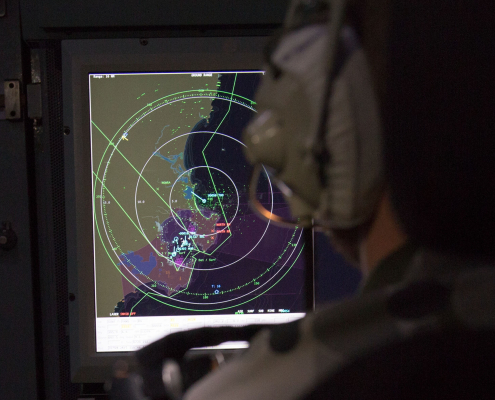Sensors & Surveillance
Successful defence and security relies on effective and integrated Intelligence, Surveillance and Reconnaissance (ISR), across multi-domains and including electromagnetic spectrum operations (electronic warfare) and use of artificial intelligence (AI).
Important to this is collection and integration of information from ISR sources and tactical systems in real or near real time to support decision making, which increasingly relies on sensors, networks, and automated information processing and reasoning (AI).
Capabilities and UWA Competitive Advantage
- Extensive expertise in advanced sensor fabrication and testing, including Infrared Imaging Array technologies, Optical micro-electro-mechanical systems (MEMS) based technologies, Transistor-based sensors, Optical and photonics sensing platforms including waveguides, and quantum sensors. Applications include:
- Night vision and security;
- Remote weapons/target signature recognition and identification
- Missile guidance and targeting
- Space situational awareness
- Electronic warfare
- High sensitivity magnetometers
- Gas, chemical, and bio sensing.
- Modelling and measurement of the effects of the atmosphere on free-space light propagation.
- Modelling of the effect of atmospheric scintillation in satellite/ground optical communications.
- Remote Sensing and Sensing Networks research groups with robotics and automation expertise in:
- sensor networks and data integration
- image analysis and recognition systems
- automatic target detection, recognition and tracking
- audio-visual biometrics dealing with authenticating persons accessing sensitive data or secure areas
- acoustic array design and signal processing
- acoustic scene classification
- audio source separation and enhancement – spoofing and counter-measures
- GIS and remote sensing including via satellite and drones
- rigid body motion, flocking and collective motion
- monitoring dynamic systems with incomplete information
- statistical analysis of key events
- spatial analytics
- analytic and differential geometry
- very large-scale data analytics.
- Information Systems/Technology including economic and quantitative analysis.
- Compliance Monitoring for Anomaly detection (CMAD) in complex environments including the stock market, energy and petroleum industry; engineering asset management; aerospace and defence.
- Information management including, knowledge management, decision support, Agent technology, e-Commerce, Artificial Intelligence applied to Business, and Asset Management work flow decision support.
- Research into creating nanomaterials for camouflaging 3D objects including expertise from biology, physics, visual psychology, art, and computer vision.
- The School of Biological Sciences has capabilities in:
- identification of biological material through DNA barcoding.
- identification of complex pollen mixtures through DNA metabarcoding.
- biogeographic interpretation of botanical data, and comparison of species composition across samples.
- method development in forensic applications of DNA barcoding and metabarcoding.
Key contact
Professor Gia Parish
Email: giacinta.parish@uwa.edu.au
Outcomes and Impact
- Investigative forensics (effectively DNA barcoding), including trace botanical DNA provides spatio-temporal biomarkers to supply evidence on the relationships and movements of materials and people of interest.
- Data management, optimisation and analytics at the exa-scale:
- Data cleaning and efficient storage.
- Quality data representation frameworks
- Efficient methods for pre-processing and integrating different types of data (numerical, textual, images, audio, video).
- Integration of data from many different sources.
- Data modelling involving mathematical, statistical and computational methodology is used to understand complex systems and processes and problems. Applications include;
- decision making for reliability and asset management
- predicting the spread of disease among communities, or the spread of bushfire through varied terrain
- Low cost sensing technologies designed for real-world applications with foci including the environment, infrastructure monitoring and airborne remote sensing.
- A new class of sensors operating in the IR part of the spectrum that provide unique multi-spectral sensing capabilities with reduced size, weight and power requirements. Applications in multi-spectral imaging, night vision, and standoff spectroscopy sensors, with a strong focus on ISR applications in defence and security.
Facilities
- UWA is a member of the Pawsey Supercomputing Centre, which operates multiple supercomputers, data-intensive machines and storage systems that use the most advanced technologies available.
- The International Centre for Radio Astronomy Research (ICRAR), which supports the development of the world’s largest radio telescope, the Square Kilometre Array (SKA). ICRAR’s engineering program specialises in antenna design, radio-frequency engineering, electromagnetic compatibility, high-performance computing, digital systems and software engineering.
- The Microelectronics Research Group through the WA node of the Australian National Fabrication Facility (ANFF) at UWA runs a completely vertically integrated Facility for in-house sensor technology research and development, from materials growth, through device design, fabrication and testing, to packaging and sub-system assembly.



